This post is in collaboration with my friends at Stark Bro’s, my #1 online source for fruit and nut trees, shrubs and other edible plants. All opinions and words are my own.
I’m not gonna lie. Pruning blackberries can be just a little confusing! Between figuring out your variety, knowing when to trim them, which canes and branches, and how long, it’s enough to make you want to just ignore the whole blackberry trellis. To clear things up, I’m gonna go through the different types of blackberries—thornless or thorned; trailing, erect, or semi-erect; and floricane- or primocane-bearing—and then take you through how to prune blackberries in spring, summer, fall and winter.
Should I Trim Blackberry Bushes?
This is a question that a lot of people ask. The answer is, yes, you should definitely prune blackberry bushes! Trimming blackberry bushes has a number of benefits including:
- Reducing disease
- Increasing airflow
- Reducing pests
- Increasing fruit yields
- More attractive plants
This last one is especially top-of-mind for me since I have a front yard garden! I’ve never had problems with neighbors or the town, but I definitely don’t need some scraggly plants to cause issues for me.

When Is the Best Time to Prune Blackberries?
Blackberries, as you’ll see, can be pruned year-round, with different cuts for different seasons. This is likely where all of the pruning confusion comes in.
Let’s start with the basics, though.
In every season, whenever you notice it, always prune out any dead, diseased or broken blackberry canes. Regardless of whether they look infected, make sure you dispose of all cuttings off your property since they could harbor disease that could then spread back to your blackberries.
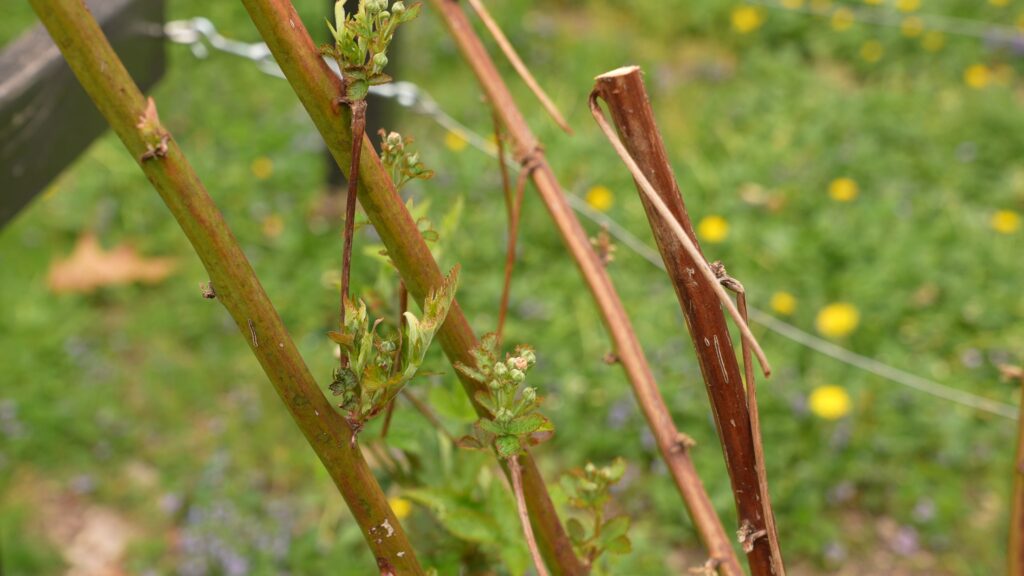
It’s best to think of blackberry pruning as ongoing regular maintenance, like weeding, harvesting, or mowing the lawn.
Identify Your Blackberries Bushes
First things first. We’ll need to ID our blackberry bush type before figuring out the best blackberry pruning method and when to prune them.
Pruning Thornless Blackberries
Do you have thornless or regular blackberries with thorns? Good news is that, as far as pruning goes, the cuts are the same. The amount of blood may not be though. So, if you have thorned blackberries, grab a heavy set of gloves, long sleeves and meet me back here.
Pruning Trailing, Erect & Semi-Erect Blackberries
You can tell the difference between trailing and erect or semi-erect (sometimes called semi-trailing) blackberries by looking at the main stems. Trailing blackberries are low-growing and spread, fanning out on the ground.
While all young blackberries ramble a bit, if they’re fairly upright and tall, you’re looking at erect or semi-erect blackberries. Most cultivated bushes are this type, so if you or someone else planted the bushes, they’re most likely erect or semi-erect, like mine. Wild blackberries are usually trailing.
Pruning Primocane vs. Floricane Blackberry Canes
Blackberries can bear fruit at two times—either on their second-year canes only, which is standard, or on both their first- and second-year canes. The first-year canes are called “primocanes,” think primo for one, and the second-year canes are called “floricanes,” think flora for flower.
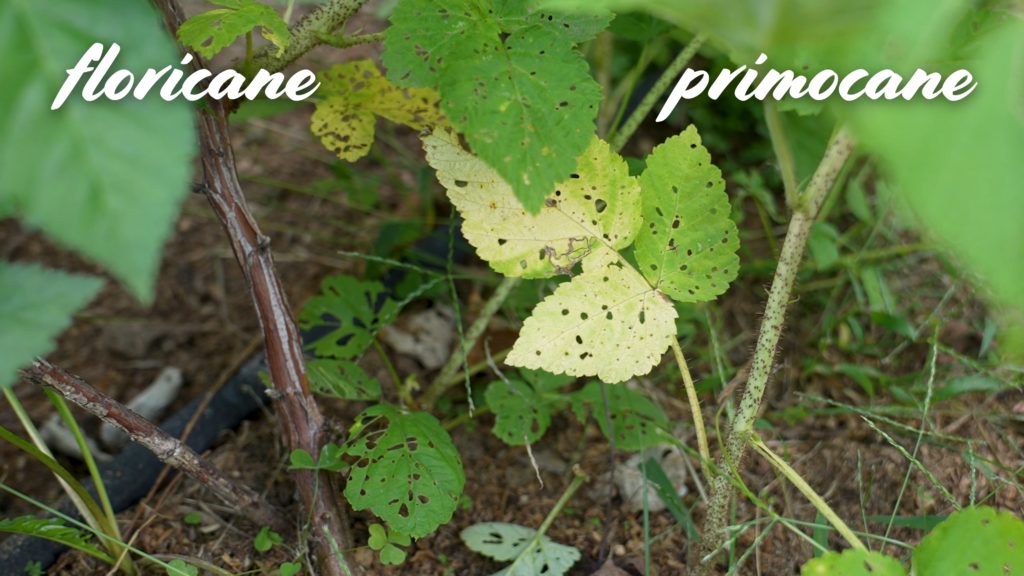
Blackberry primocanes are bright green and more pliable. The two-year old floricane is much darker, red or brown sometimes and is much stiffer. All floricanes flower and bear fruit and then die. Typical primocanes do not flower or bear fruit, but primocanes of “everbearing” varieties will stay green at the bottom and flower and bear fruit at their tips.
These blackberry varieties that fruit on their primocanes and floricanes are called “primocane berries” or “everbearing,” even though all canes die after two years. Note that the crowns, the base of the plant, can live 15-40 years. It’s just the canes that come and go.
If you only get blackberries in the summer, or if they’re only one time per year, you likely have a standard blackberry that fruits on its second-year canes. Popular standard floricane-only bearing varieties include: Chester Thornless, Natchez Thornless, Ouachita Thornless, and Triple Crown Thornless.
If you get blackberries twice a year, summer and fall or have an elongated season, then you likely have an everbearing variety. Another trick is to look at the canes. If you see canes that are dead and covered with old berries at their tops, but green and budding on their bottoms, you have an everbearing variety.
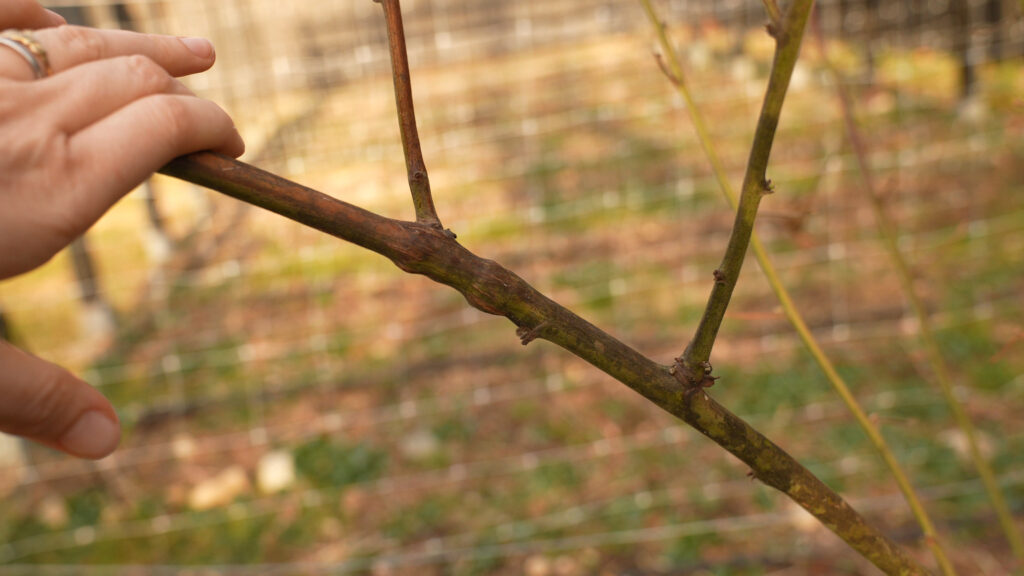
I have two extremely prolific, yummy everbearing blackberry varieties in my garden, Prime Ark Traveler and Prime Ark Freedom from Stark Bro’s. I got these precisely because I wanted a longer season of blackberries. Both the Traveler and Freedom fruit in June on their floricanes and July on their primocanes, with both canes fruiting until first frost, which is November 15th for me in Zone 7. This gives me five solid months of pretty near daily fruit!
I usually eat them fresh in the yard while I’m picking. Very little makes it into the house, much to the dismay of my husband! (I think he’s convinced the plants don’t produce. We’ll let him continue believing that, hehe.)
These two varieties are the gold standard for everbearing blackberries but some other popular primocane blackberries include: Prime Ark 45, Stark Black Gem, and this adorable container variety Bushel and Berry Baby Cakes Blackberry.
How To Trim Blackberry Bushes
To get started you’ll need a pair of pruners for the smaller canes and lateral branches and a lopper for the thicker canes.
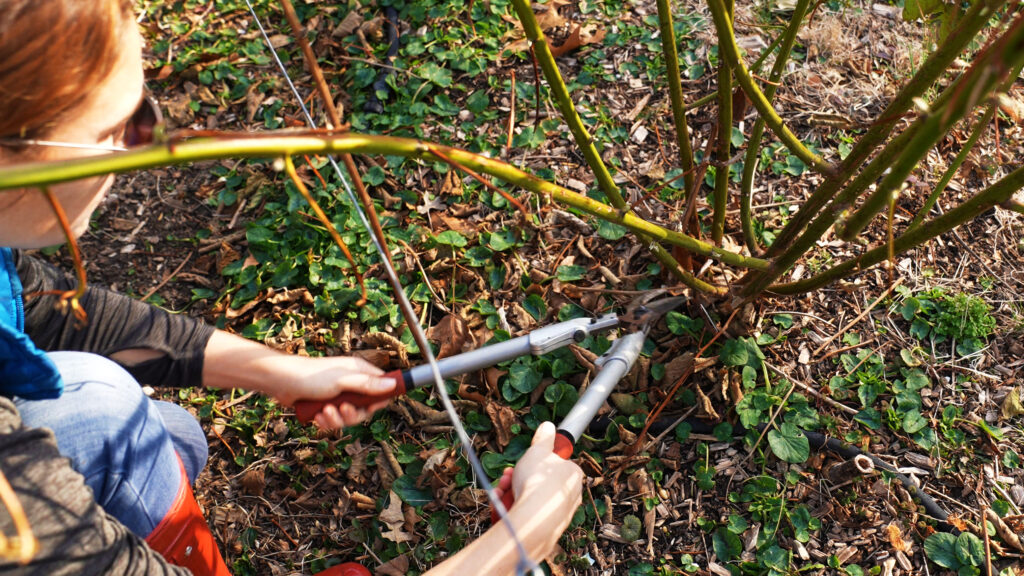
How To Prune Blackberries in Spring
If you skipped your winter blackberry pruning, you can still do a lot of the dormant pruning in early spring, so stay tuned for winter pruning directions.
If your winter pruning has been done, there’s not too much to prune in spring unless you have a trailing variety. This is the time to cut the main cane of trailing blackberries at the top to a height of 3-4 feet (1-1.5m).
Now’s also a great time to double-check that everything’s starting to bud out and survived the winter. Even blackberries that were pruned down to the ground will eventually show signs of life. If you’re not sure whether your berries made it, do a scratch test by scraping a few canes with your fingernail. You can also prune canes down until you find living wood, which will be green and wet.
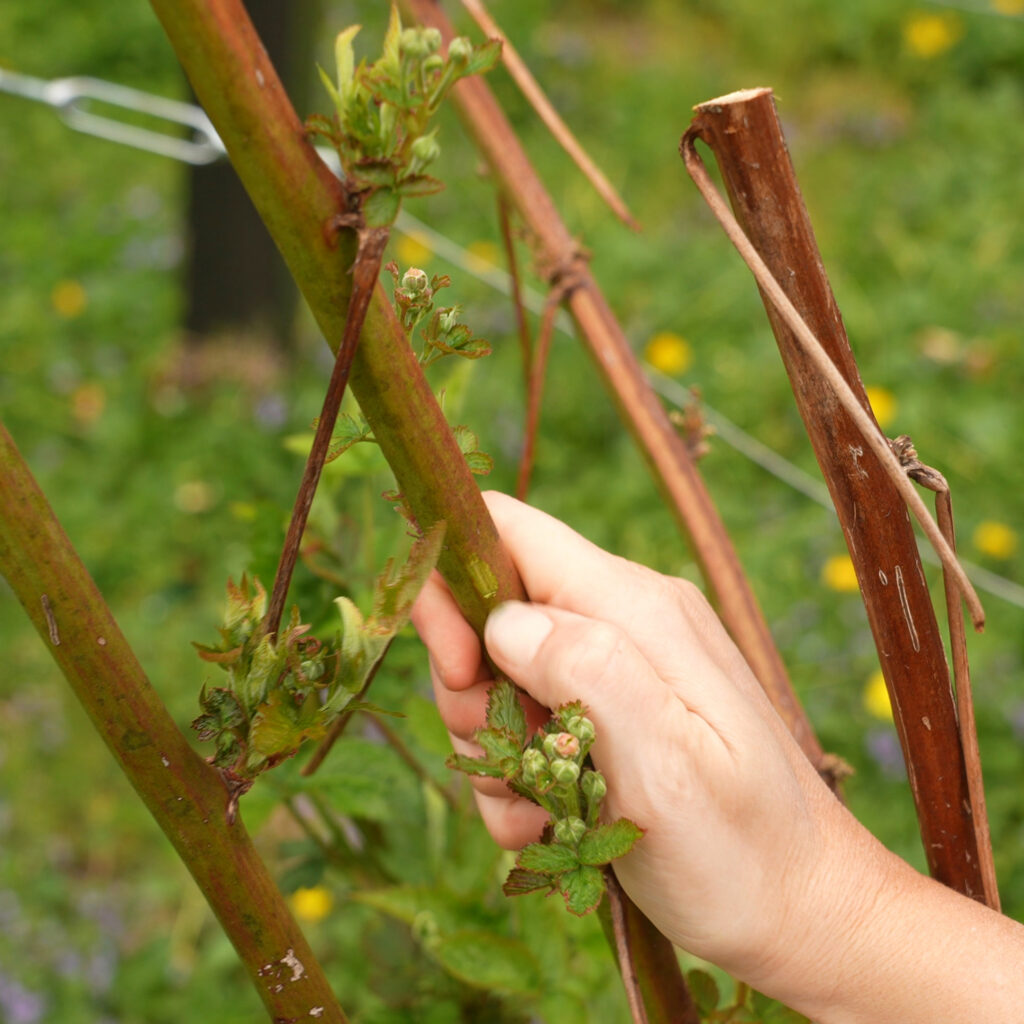
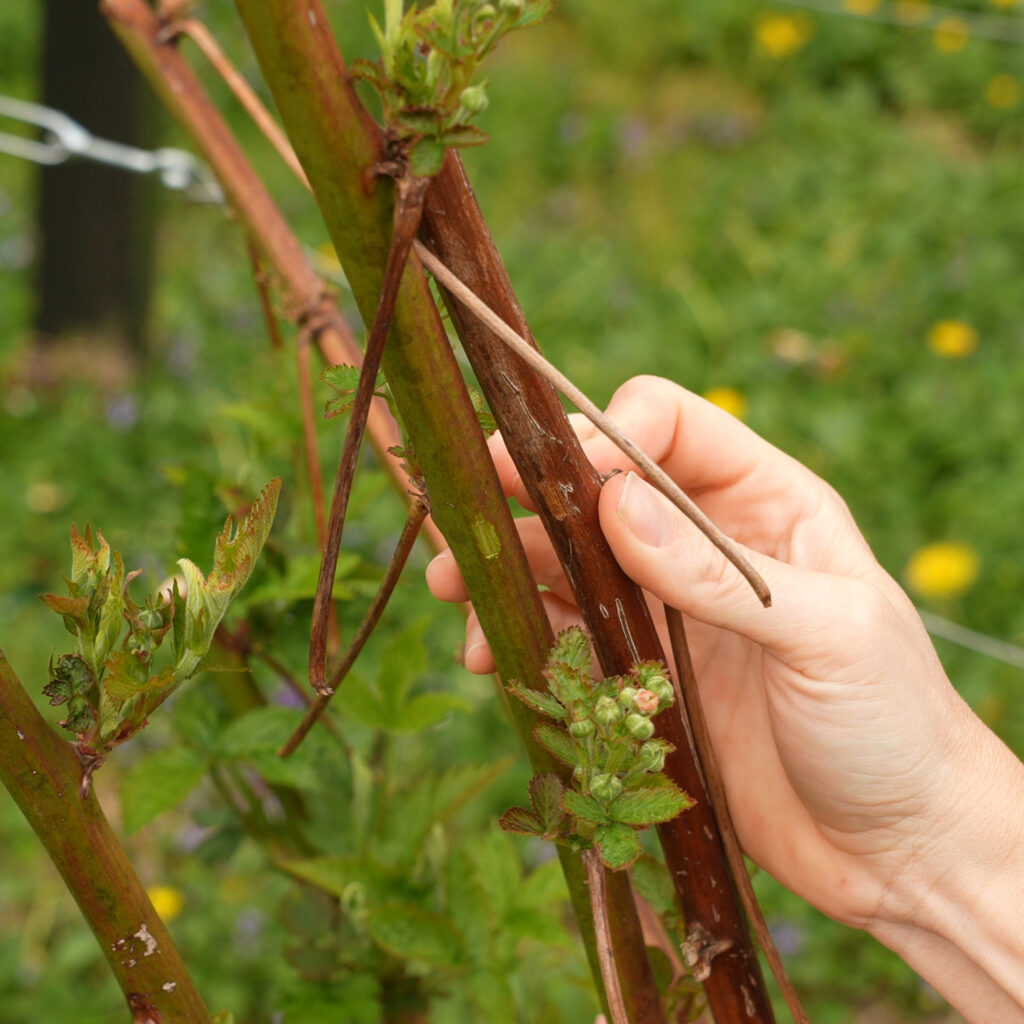
Temperatures below 0ºF in the winter can damage canes. If you have a man down (i.e. a dead plant), check with your nursery to see if they have a survival guarantee and can replace it for free. Though I have many plants in my front yard garden from Stark Bro’s, I’ve had the good luck to never need the amazing Stark Bro’s 1-Year Survival Guarantee. It’s a guarantee that has always given me an incredible peace of mind as I place my plant orders every year. If you’re looking to invest in plants for your garden, I definitely recommend purchasing from a company that has a guarantee like this.
Summer Pruning Blackberries
1. Head the main canes
Pruning blackberries in the summer consists mainly of controlling the height of the bushes. Cutting the tops of the canes is called a “heading cut” and you might need to do this a couple times in the summer to keep everyone in line. Heading cuts for almost all plants encourage growth further down on the stem, and in the case of blackberries encourage fruit production.
Prune erect and semi-erect varieties 3-5 feet high. I pruned mine towards the lower end of this range, but I think next year, I’m gonna do it high enough so that the canes clear the top wire of my blackberry trellis for support.
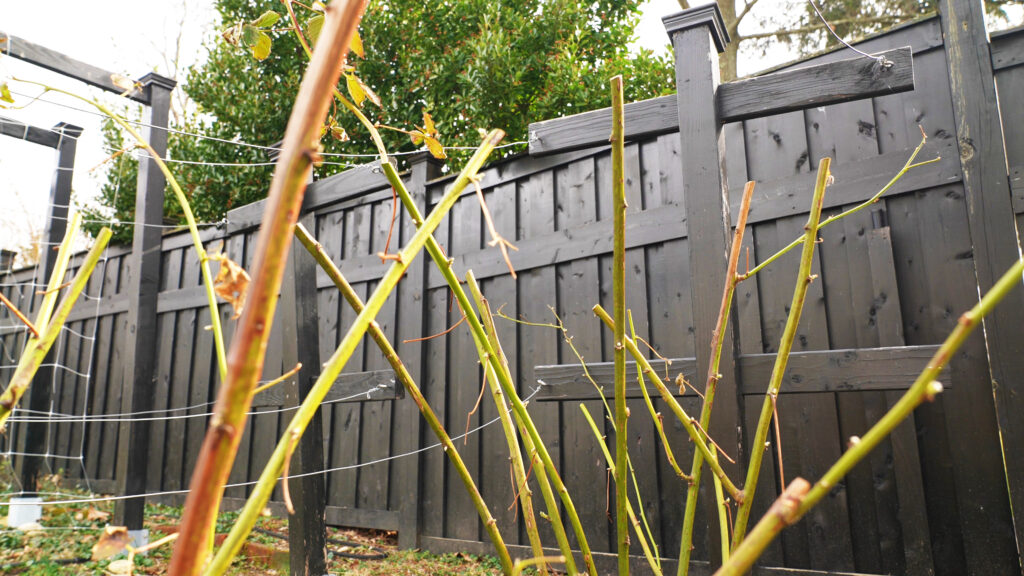
2. Thin the spent floricanes
The other important prune to make in the summer is to remove dead floricanes after harvest. As the season progresses, each cane will bear fruit and die. Removing these canes sooner rather than later clears the way for new primocanes emerging at this time of year and also cuts down on disease transference.
3. Tip the dead primocane ends
If you have an everbearing variety, just make sure not to remove a primocane! Everbearing primocanes look like floricanes on their ends—dead and covered with berry debris at the end of the season. Their bottoms are still primocanes, though, green and growing. For these hybrid canes, just cut off the spent ends.
Do You Cut Back Blackberry Bushes in the Fall?
Fall is not a common time to prune blackberry bushes, but the surprising answer to this question is…Yes, you can prune blackberries in the fall, specifically everbearing varieties.
Because everbearing varieties bear fruit the first year on the primocanes, some growers cut down blackberries every year all the way to the ground in the fall when they’re done producing. Because of this, floricanes, second year canes, are never produced. This is called “fall-managed blackberries” or “managing for a fall crop.” This method is also described as “mowing down” the plants, but don’t be fooled by the word “mowing.” If you try to use your lawnmower on these things—your lawnmower will not win! The lopper is the tool here.
You might want to consider cutting down everbearing blackberry bushes every year if:
- You don’t need two harvests in a year
- You already have other blackberries that produce in the early summer
- It’s easier not to worry about upkeep of the plant (i.e. pruning, protecting from cold, early summer harvesting)
- You live in a cooler region where the primocane harvest is usually bigger anyways
- You prefer the clutter-free look during the winter
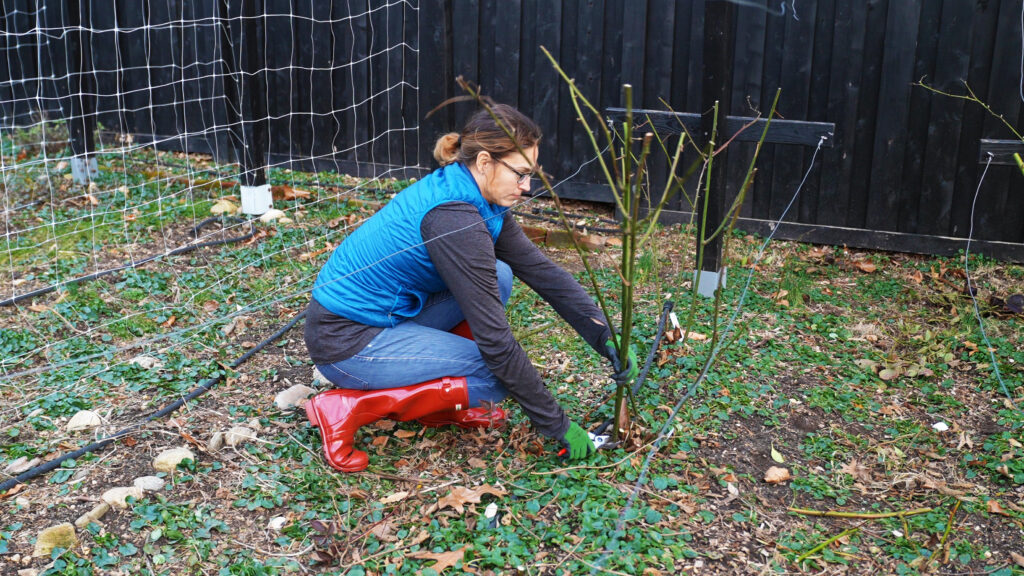
This year, I pruned one of my trellises in this method to test it out. I was intrigued with the idea of not having unsightly naked canes in my front yard over the winter. More importantly, though, cut back to the ground, the canes would not be leafing out and shading my tomato trellises in early spring when the tomato seedlings were just finding their way up the trellises. The tomatoes and fresh primocanes would be more on equal footing.
I’m not gonna lie, I was a little hesitant to take these guys down to the ground, but a spring inspection showed me that they were doing just fine and starting to send out shoots.
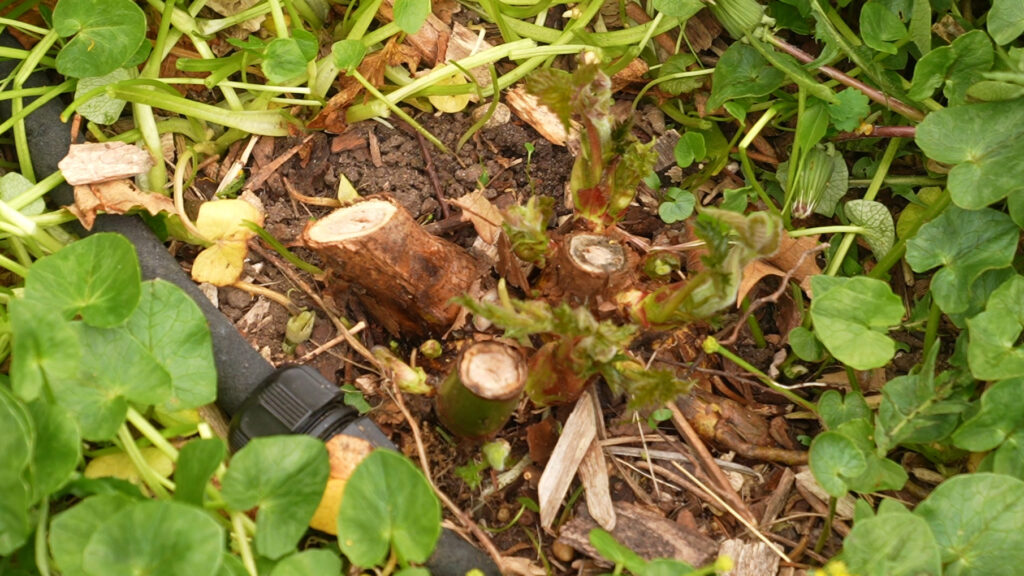
Pruning Blackberries in Winter
Winter is the most common time to prune blackberries. In fact, before wising up, I used to do all of my pruning in one fell swoop in the winter. Smarter April does not recommend this! Besides being an incredibly long and stressful day, it’s actually not good for the blackberries (or your fruit yield!) to be overgrown and filled with dead, broken and diseased canes all year, waiting on you. (Yes, you, April.)
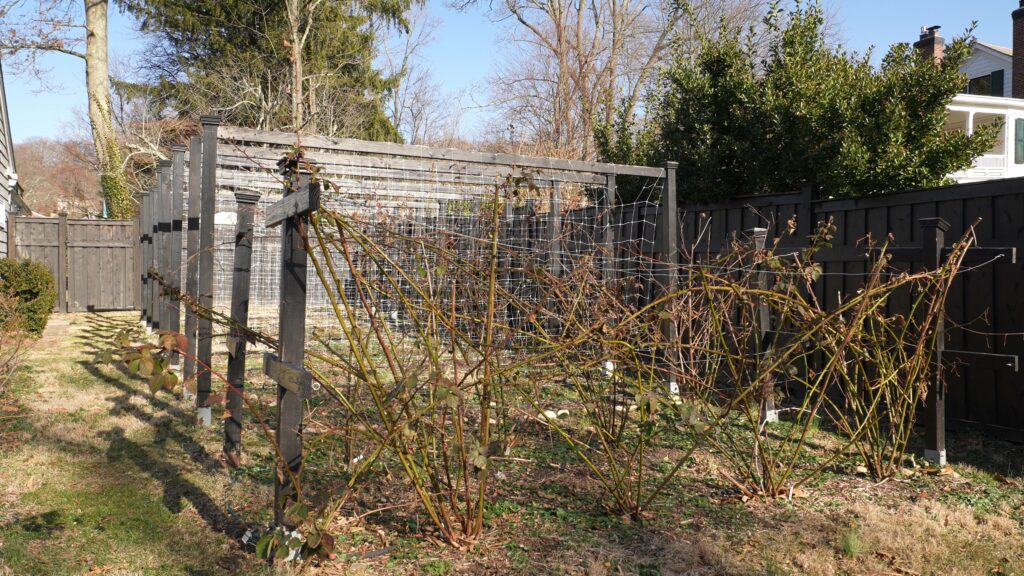
Let’s say you’ve been on top of your maintenance all year. Spent floricanes are already gone and all the remaining canes are green, undamaged, and disease- and pest-free. You also managed to keep the bushes to proper height all season. Go you. There’s still some more prunes to make.
1. Thin the canes
The first step is to remove all but 4-6 of the strongest primocanes on each plant, or 3-4 canes per foot. Keep in mind, you should have zero floricanes since you removed those as you harvested earlier in the year. You’d think that reducing the canes would reduce fruit yield or quality, but there are a couple reasons for thinning blackberries. Thinning:
- focuses the energy of the plant on just those canes
- increases airflow
- increases sunlight
- reduces the chances of rubbing branches and the resulting damage
- decreases risk of disease
- allows room for new primocanes to emerge
2. Remove lower lateral branches
The laterals are the horizontal branches that grow off the main canes. We want to remove any lower than 18 inches off the ground. Like tomatoes and many other plants, any fruit that grows on these lower branches will likely be more affected by animals, insects, shade, and disease. Instead, we want the blackberry to focus its energy on higher branches where the fruit will be better quality.
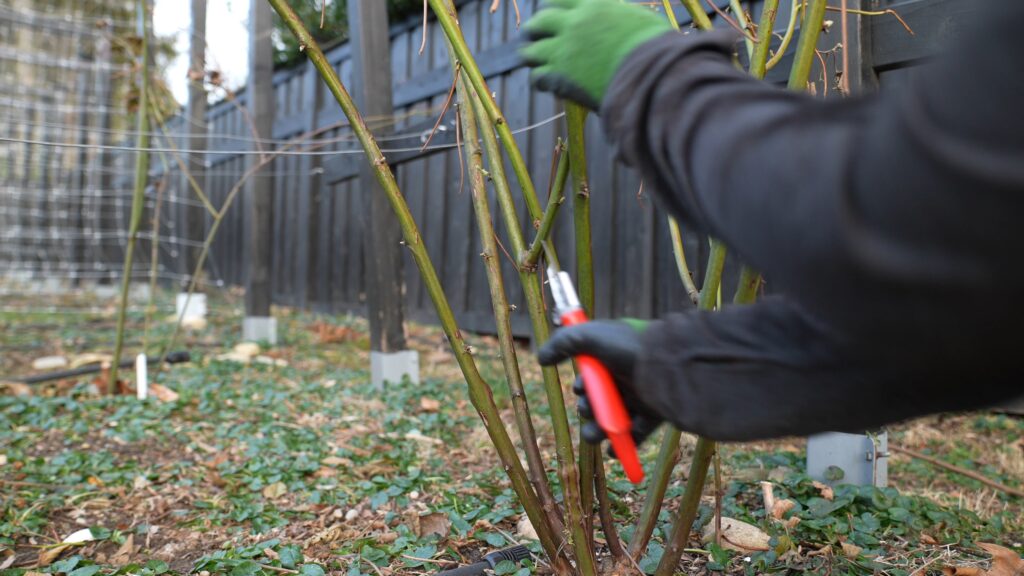
3. Trim the lateral branches
The remaining laterals we want to prune back (a heading cut) to 12-18 inches long, making sure each has 5-6 buds.
For a great follow-along video of winter pruning, check out this fantastic video from Stark Bro’s.
With all those prunes done, your blackberry winter pruning is done for the year! Just check again in spring, to make sure all the canes got through the winter okay and there was no additional damage.
Looking to Grow Blackberries?
If you’re wondering if you can take care of blackberries, the answer is… Yes, you can do this! Just follow along for each season and pruning blackberries will be a cinch, just another part of your regular garden maintenance.
Long before I started my YouTube channel and this website I was just a regular gardener—although one with a front yard garden! Stark Bro’s helped me get my start. I purchased my blackberries, my strawberries, my blueberry hedge, my raspberries, my potato seeds, and my sweet potato slips all from Stark Bro’s.
They are an old company, established in 1816, over 200 years old. In an age when companies seem to be declaring bankruptcy left and right, that’s an incredible legacy! My non-gardening mother has even heard of Stark Bro’s. They’re most famous for bringing the Golden Delicious and Red Delicious apples to market, making these varieties some of the most well-known apple varieties we eat today.
What I appreciate most about Stark, besides their healthy plants, is that they keep up with times. Their website works great and it’s stuffed with plant information. In the case of purchasing my blackberries, it took one click in their shop filter to find which ones were primocane-bearing and worked with my zone. They also have a variety of USDA-certified organic plants. My organic garden couldn’t be happier to have these options!
If you are in the market to buy blackberries, or any other fruit, nut tree or edible, I highly recommend Stark Bro’s. I’m so excited to be partnering with them on this post. Stay tuned for more with them soon!
Sources
- Pruning and Training Caneberries (Blackberries and Raspberries), The University of Tennessee Institute of Agriculture
- Pruning Blackberry Plants, Stark Bro’s
- Growing Blackberries in Your Home Garden, Oregon State University

This post is sponsored by Stark Bro’s. View the full ReSprout advertising disclosure.


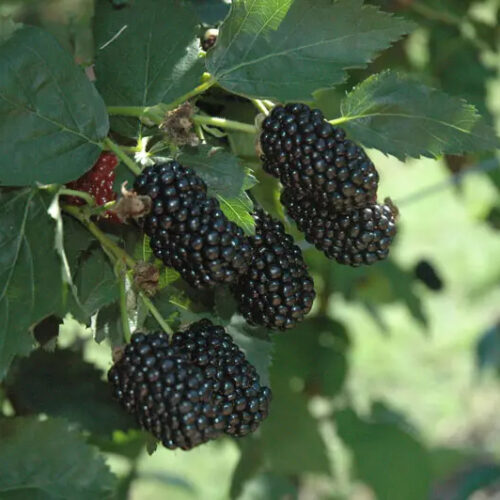
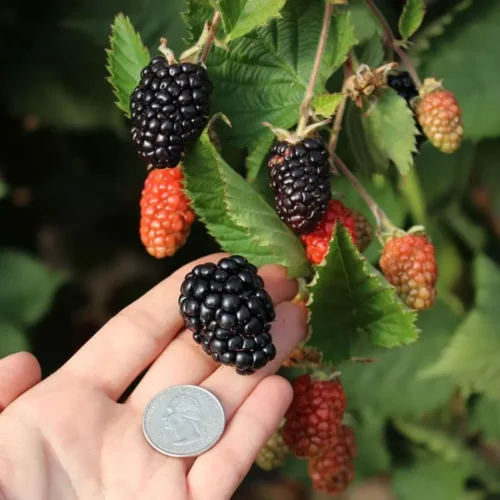


Thanks for the helpful tips. My blackberry plants are purely ornamental. By the time they start to ripen they’re picked clean by the birds and squirrels.
Jeff, I feel like that sometimes too! Have you tried row cover fabric? Not the prettiest thing in the world, but that will keep them off.
Hi April, I was introduced to blackberries by my neighbor. I bought tgwo types, Navajo and arapaho, which produced a huge amount of blackberries lasty year. About 7 lbs! This year I was expecting the same but I got only 2 lbs. Feeling dismayed, I bought two babycakes. Are they everbearing? It sounded as if they may be. I have not pruned either bush but one babycakes is nearly 6 ft tall. When I prune it, Could I replant the part I trimmed? If so, do I need propagating hormone? Also I need advice about a blackberry fence to wrap the stems off the ground. Thank you for the great website.
Sometimes gardening is like that unfortunately! One year I got 25 cucumbers in ONE DAY and the next year, I think I got about the same for the whole season. On the Babycakes, they do produce twice a year, so they are considered “everbearing,” though they won’t be bearing fruit 365 days a year. For propagating, I would definitely try at least putting it in water to make sure roots grow, and if not, then use a hormone. Once you see roots, then go ahead and plant. By “fence” do you mean a trellis? If so, here’s a DIY build video on the trellis I have in my garden – https://www.youtube.com/watch?v=EzRlNg8nMLk. Enjoy!
Hi april…I’ve been growing blackberries for several yrs and I still found article very knowledgeable and informing…Got my first bb starts from starks….high quality and healthy plants…I’m still growing off those starts 20 years later…thank you for posting..❤️ Your information was really good…
Oh, I’m so glad you enjoyed Paul! Starks is great! I’ve been a customer of theirs for decades, even before I started ReSprout. 😀
So what do you do with the plants where both ends are in the ground? Can you cut them in the middle and make two plants out of one?
Yes, you CAN do that actually! It’s crazy how those things grow! For that reason, if you’re NOT looking for it to spread, make sure they don’t touch the ground. 😉